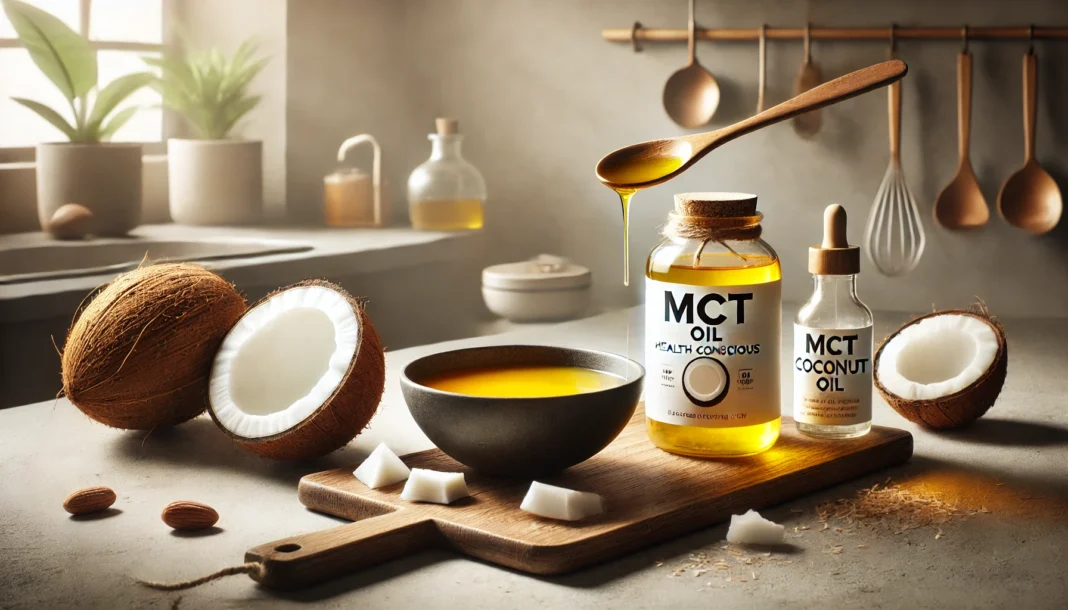Introduction
MCT oil has carved a unique niche in the world of functional nutrition and metabolic science. Known for its rapid absorption, cognitive-boosting potential, and ability to support fat metabolism, this oil—derived predominantly from coconut and palm kernel oil—is a favorite among athletes, biohackers, and health-conscious individuals alike. But beyond its reputation as a supplement, a growing number of people are asking a deeper question: can you cook with MCT oil safely and effectively, or do its properties limit its culinary uses?
You may also like: MCT Oil for Dementia and Brain Health: Exploring Its Role in Memory, Function, and Alzheimer’s Support
Cooking oils are not created equal. Their nutritional value, behavior under heat, and interaction with other ingredients can make or break a dish—not to mention impact your long-term health. The debate around MCT oil and its viability for cooking revolves around its relatively low smoke point and unique molecular structure. Some believe it is best reserved for cold dishes or added after cooking, while others are experimenting with integrating it directly into warm recipes and low-heat cooking.
The core concern stems from whether the beneficial fats in MCT oil maintain their structural integrity when exposed to heat. Additionally, questions about how it compares to more traditional cooking oils like olive oil, coconut oil, or avocado oil continue to arise. Many are searching for definitive answers: can you use MCT oil for cooking on the stove, in the oven, or in everyday meal prep routines?
In this science-backed, in-depth article, we’ll answer those questions and more. We’ll explore what makes MCT oil unique, how it behaves under different cooking conditions, what happens when it is heated beyond its threshold, and whether it remains a healthy option when exposed to culinary temperatures. We’ll also examine how to best integrate MCT oil into your cooking strategy without compromising its powerful metabolic and cognitive benefits.
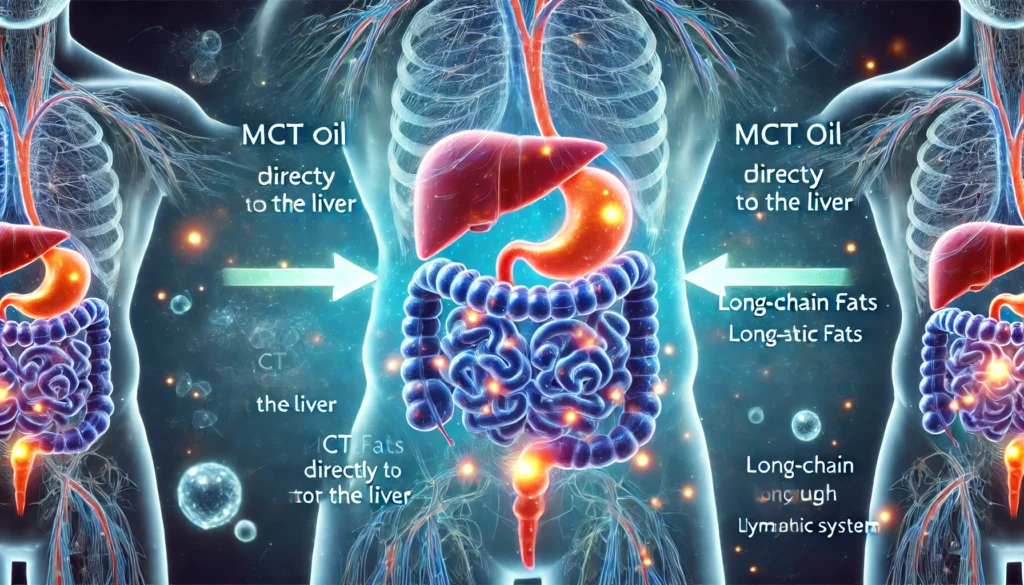
What Makes MCT Oil Different from Other Fats?
MCT stands for medium-chain triglycerides, a specific group of fatty acids made up of carbon chains ranging from 6 to 12 carbon atoms in length. These fatty acids—most commonly caproic acid (C6), caprylic acid (C8), capric acid (C10), and lauric acid (C12)—are metabolized differently from their long-chain counterparts. Unlike long-chain triglycerides (LCTs), which are digested and absorbed through the lymphatic system, MCTs are absorbed directly into the portal vein and sent straight to the liver.
Once in the liver, MCTs are quickly converted into ketones—an alternative energy source used by the body and brain when glucose is in limited supply. This process is much faster than the typical fat metabolism pathway, which is why MCT oil is favored in ketogenic diets, intermittent fasting protocols, and cognitive performance stacks.
Because of this rapid conversion into usable energy, MCT oil is praised for supporting fat oxidation, increasing satiety, boosting mental clarity, and even helping manage certain neurological conditions like epilepsy and Alzheimer’s disease. However, despite these impressive benefits, its use in cooking demands closer examination due to its low smoke point and refined chemical structure.
What Is the Smoke Point of MCT Oil, and Why Does It Matter?
The smoke point of an oil refers to the temperature at which it begins to break down and produce visible smoke. This is not just a sensory issue—it signals the degradation of the oil’s molecular structure and the potential formation of harmful compounds like free radicals, acrolein, and trans fats.
MCT oil typically has a smoke point ranging between 280°F and 320°F (138°C to 160°C), depending on its purity and the concentration of specific fatty acids. This makes it significantly less stable under heat than many other oils commonly used in cooking. For context, avocado oil has a smoke point of around 520°F, refined coconut oil comes in at 450°F, and even extra virgin olive oil offers a smoke point of 375°F.
The relatively low smoke point of MCT oil means it’s not suited for high-heat applications such as frying, searing, or broiling. Doing so can compromise its nutritional benefits and result in the formation of substances that are best avoided in a health-conscious kitchen.
Understanding this critical aspect is essential before integrating MCT oil into your cooking regimen. While it remains a powerhouse in terms of health benefits, knowing its thermal limits can help preserve its nutritional value and ensure that you’re using it safely and effectively.
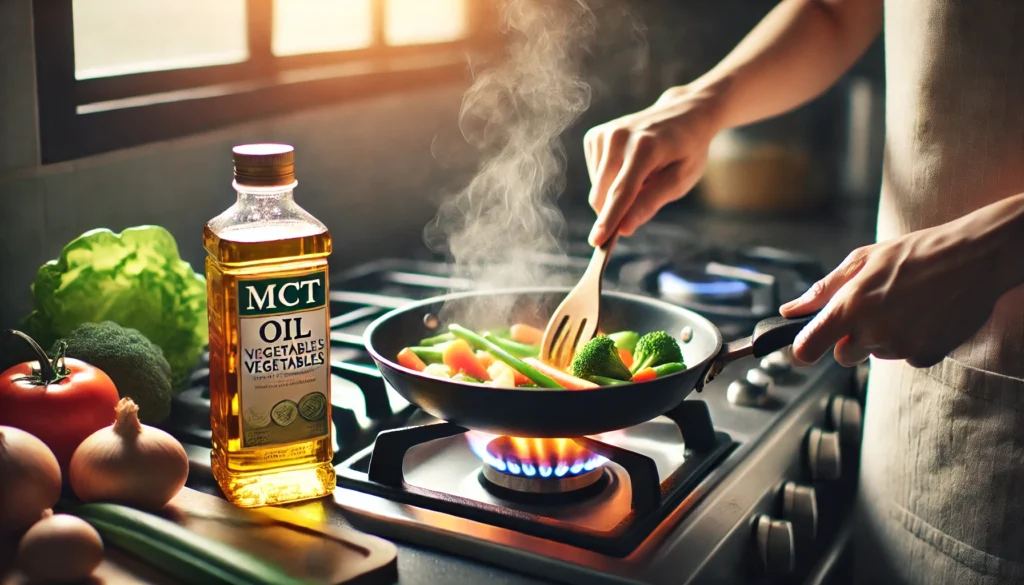
Can You Cook With MCT Oil at Low to Moderate Temperatures?
Yes, cooking with MCT oil is feasible under specific conditions—namely, when the cooking process stays below the oil’s smoke point. Low-heat cooking methods such as gently sautéing vegetables, warming sauces, or preparing eggs on low heat can be compatible with MCT oil, provided that you’re cautious with temperature control.
It’s essential to note that the temperature of stovetop pans can exceed 375°F within a few minutes on medium to high heat, which is well beyond the safe threshold for MCT oil. As a result, this oil is best used in recipes that involve minimal direct heat or where it can be added after the cooking process is complete.
For example, adding MCT oil to steamed vegetables just before serving allows you to reap its benefits without risking thermal degradation. Similarly, incorporating it into low-temperature baked goods—such as muffins or protein bars—is generally safe because the oil is dispersed throughout the batter and does not reach extreme temperatures.
Another approach is to blend MCT oil into warm dishes right before serving. Soups, stews, or warm grain bowls can all be enhanced with MCT oil when stirred in after cooking. This ensures the oil’s structure remains intact, while also enhancing the texture and nutritional profile of the meal.
Can You Use MCT Oil for Cooking in the Oven?
When it comes to oven-based cooking, MCT oil can be used more safely in certain contexts than it can on a stovetop. While baking often involves high oven temperatures, the internal temperature of the food rarely exceeds 212°F due to the moisture content. This means that the oil is less likely to reach its smoke point during baking compared to frying or searing.
In recipes where MCT oil is mixed into a batter or dough—such as low-carb cookies, keto muffins, or protein bars—it is well-protected and unlikely to degrade significantly. However, if MCT oil is drizzled on top of a dish and directly exposed to oven heat, the risk of oxidation increases, particularly in dry baking environments.
To ensure safety and effectiveness, it is best to use MCT oil in oven recipes that involve internal mixing rather than surface exposure. The oil should be part of a moist, protected matrix rather than sitting on top of food that is baked at high temperatures. This strategic application allows you to retain MCT’s nutritional advantages while still enjoying the benefits of baked foods.
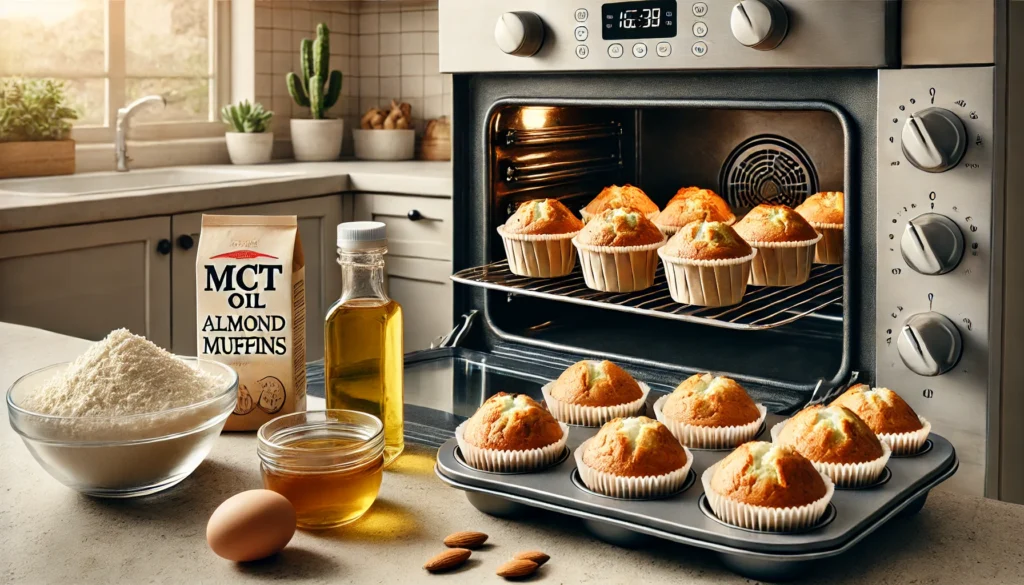
Can You Use MCT Oil for Cooking on the Stove?
Using MCT oil for stovetop cooking is possible, but with clear limitations. If your cooking technique involves prolonged heat or reaches high temperatures quickly, such as pan-frying or stir-frying, MCT oil is not an appropriate choice. These methods can cause the oil to surpass its smoke point, resulting in both loss of health benefits and the generation of undesirable byproducts.
However, in cases where the heat is kept intentionally low, such as warming spices, gently cooking eggs, or preparing sauces on low simmer, MCT oil can be integrated carefully. Still, even in these situations, the oil should not be left in a hot pan for an extended period.
An optimal solution is to use a more heat-stable oil like avocado, ghee, or refined coconut oil for the cooking process and then add MCT oil after removing the dish from heat. This method allows for full preservation of MCT’s properties while enjoying the culinary richness and functional benefits it offers.
How Does Heating Affect the Nutritional Profile of MCT Oil?
The health benefits of MCT oil—ranging from improved energy metabolism to enhanced brain function—depend on the integrity of its fatty acid chains. These medium-chain triglycerides, especially C8 and C10, are most beneficial when consumed in their unaltered form. Unfortunately, when exposed to temperatures beyond the smoke point, the molecular structure of MCTs begins to break down.
This breakdown not only reduces the bioavailability of the medium-chain fats but also results in the formation of compounds that can promote oxidative stress and inflammation in the body. Over time, regular consumption of degraded oils may contribute to chronic health issues rather than the optimized performance MCT oil is typically associated with.
In practical terms, this means that while you can use MCT oil for cooking in low-heat scenarios, you should avoid using it in a way that compromises its therapeutic properties. The better strategy is to reserve it for raw applications or gently heated dishes where its benefits remain intact and its structure unaltered.
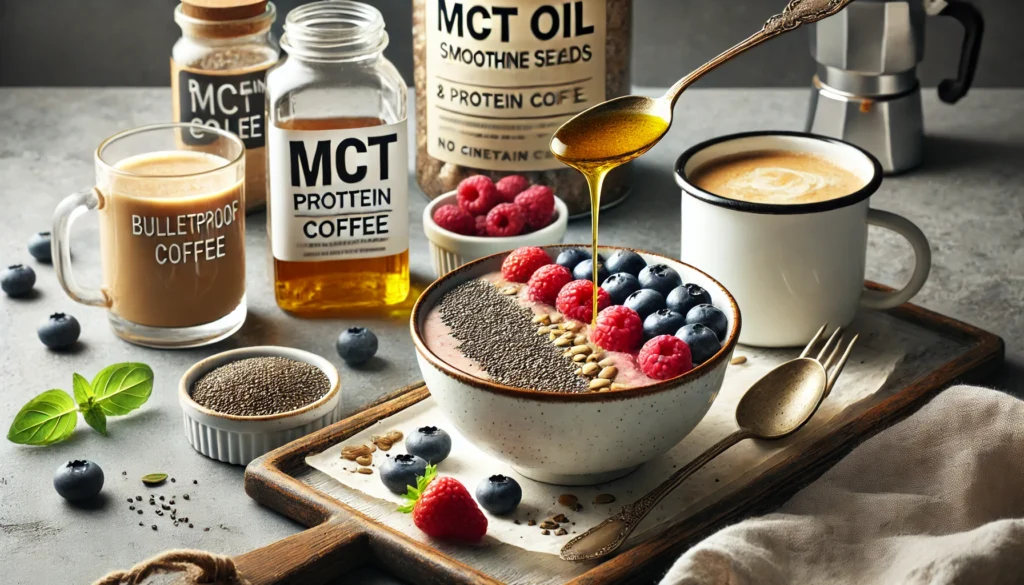
How to Best Incorporate MCT Oil into Your Meals
The most effective way to use MCT oil in cooking is not necessarily to treat it like a traditional cooking fat, but rather to view it as a functional nutrition ingredient. MCT oil works beautifully when added to smoothies, protein shakes, salad dressings, and low-temperature sauces. It can also be stirred into warm beverages like coffee or tea, provided the temperature remains below the oil’s smoke point.
Adding MCT oil to breakfast bowls, yogurt, or overnight oats allows you to increase satiety and energy without any risk of heat damage. You can also incorporate it into condiments such as homemade mayonnaise, keto sauces, or pesto, which are typically prepared in cold conditions.
This strategic use not only preserves the oil’s health-promoting qualities but also introduces an efficient way to boost your dietary fat intake—especially important for those following ketogenic or low-carbohydrate eating plans.
How Does MCT Oil Compare to Other Cooking Oils?
In the realm of culinary fats, MCT oil stands apart primarily due to its metabolic efficiency rather than its cooking resilience. Compared to olive oil, which is rich in monounsaturated fats and antioxidants, MCT oil is more easily converted into energy but far less heat-stable.
Coconut oil shares a similar fat composition but includes a wider range of triglyceride types, including long-chain fats and lauric acid. This gives coconut oil a higher smoke point and better utility in high-heat cooking, though its metabolic benefits are not as potent as pure MCT oil.
Avocado oil is a superior option for high-heat cooking due to its extremely high smoke point and healthy fat profile. However, it lacks the rapid energy conversion and potential cognitive enhancements that define MCT oil.
Butter and ghee are traditional favorites with robust flavor and decent heat tolerance, but they contain cholesterol and milk solids that may not fit every dietary framework.
Ultimately, MCT oil is best thought of as a supplemental or finishing oil. Its role in the kitchen is distinct from traditional fats, and using it appropriately ensures that both your meals and your health goals are well served.
Frequently Asked Questions
1. Can you cook with MCT oil in baked recipes without losing its benefits?
Yes, MCT oil can be used in baked recipes, particularly when it is blended into batters or doughs rather than drizzled on top. Since the internal temperature of most baked goods stays below 212°F due to moisture content, the oil remains protected and stable during the cooking process. This makes it a suitable option for low-carb muffins, protein bars, and other keto-friendly baked items. However, it is important to ensure that the oil does not become directly exposed to higher heat on the surface, where it might surpass its smoke point and lose nutritional value.
2. What happens when MCT oil is heated above its smoke point?
When MCT oil is heated beyond its smoke point, its triglycerides begin to break down, releasing smoke and forming degradation byproducts. These byproducts can include free radicals, acrolein, and other reactive aldehydes that not only impart off-flavors but may also pose health risks when consumed regularly. Overheating diminishes the oil’s metabolic benefits and undermines its ability to support energy, cognitive function, and fat metabolism. For this reason, avoiding high-heat applications is essential to preserve the oil’s functional properties.
3. Is MCT oil suitable for family meals and cooking for children?
MCT oil is generally considered safe for children when used in moderate amounts and introduced gradually. However, large doses may cause digestive discomfort, including cramping or diarrhea, especially in younger individuals who are not accustomed to high fat intake. When preparing family meals, MCT oil can be included in smoothies, yogurt, or drizzled over warm food after cooking. It should not be used for frying or high-heat cooking, and portion sizes should be kept small to assess individual tolerance.
4. Can MCT oil be used for deep frying?
No, MCT oil is not appropriate for deep frying. Deep frying typically involves oil temperatures ranging from 350°F to 400°F, which far exceed the smoke point of MCT oil. Using it in this way would lead to rapid degradation, the release of smoke, and the formation of harmful compounds. If you’re seeking a healthier frying oil, consider avocado oil or refined coconut oil, both of which offer higher thermal stability and better performance under extreme heat.
5. Will heating MCT oil destroy its ketogenic effects?
Heating MCT oil above its smoke point can reduce its ketogenic effects by breaking down the medium-chain fatty acids that are responsible for ketone production. The unique advantage of MCT oil lies in its rapid conversion to ketones in the liver, a process that depends on the structural integrity of the fatty acid chains. Overheating can disrupt these chains, making the oil less effective in supporting ketosis. For those following a ketogenic diet, it’s best to use MCT oil in cold or gently warmed applications to retain its full metabolic impact.
6. Is it okay to sauté vegetables with MCT oil?
Light sautéing on low heat may be acceptable if the pan temperature remains below the oil’s smoke point. However, since sautéing often involves higher temperatures than anticipated, it’s safer to use a heat-stable oil for the cooking process and then add MCT oil after removing the vegetables from heat. This technique allows you to benefit from the oil’s nutritional properties without risking degradation. It also enhances the flavor and richness of the dish in a more controlled and health-conscious manner.
7. Is MCT oil better than coconut oil when it comes to cooking?
While MCT oil contains a higher concentration of beneficial medium-chain triglycerides, it is less suitable for cooking than coconut oil due to its lower smoke point. Coconut oil contains a mix of MCTs and LCTs and is more stable at higher temperatures, making it a better choice for frying and sautéing. However, MCT oil is superior in terms of metabolic efficiency and rapid energy conversion. Therefore, coconut oil is better suited for high-heat cooking, while MCT oil is better used as a supplement or finishing oil.
8. How should MCT oil be stored if used regularly in the kitchen?
MCT oil should be stored in a cool, dry place away from direct sunlight and heat sources. While refrigeration is not necessary, it should be kept in a tightly sealed container to prevent oxidation. Proper storage helps maintain the oil’s freshness, flavor, and nutritional quality. If you use it regularly in the kitchen, consider transferring a small portion into a dark glass bottle with a pour spout for convenience while keeping the rest stored securely.
9. Can MCT oil be added to soups and stews after cooking?
Yes, adding MCT oil to soups and stews after the cooking process is an excellent way to incorporate its benefits without risking heat degradation. Once the dish has finished simmering and has been removed from direct heat, a tablespoon of MCT oil can be stirred in to enhance texture and provide a steady source of energy. This method ensures that the oil retains its nutritional potency and contributes a smooth, velvety mouthfeel to the final dish.
10. Is it safe to cook eggs with MCT oil?
Cooking eggs with MCT oil is possible if done at low heat, such as soft scrambling or gently cooking omelets. However, because eggs often require higher heat to achieve desired textures, it’s safer to cook them using a more stable oil and then drizzle MCT oil over the finished product. This approach preserves the flavor and health benefits of both ingredients and avoids exposing the MCT oil to potentially damaging temperatures.
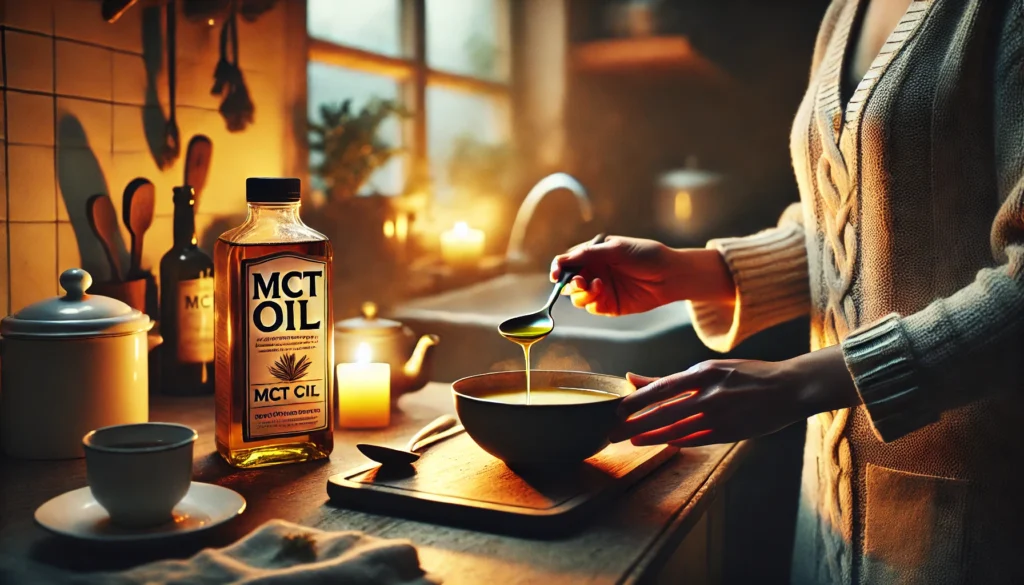
Conclusion
MCT oil offers a remarkable range of health benefits, from rapid energy conversion to cognitive support and improved metabolic function. However, its role in the kitchen must be approached with care. While you can cook with MCT oil in low-heat applications and integrate it into baking and warm dishes, it should never be used for high-heat methods like frying or searing. Understanding its smoke point, chemical structure, and culinary versatility allows you to leverage its benefits without compromising safety or nutrition.
Whether you’re exploring ketogenic cooking, seeking mental clarity, or aiming for better weight management, incorporating MCT oil correctly can elevate your nutrition strategy. Focus on adding it to smoothies, warm beverages, sauces, and low-temperature meals to maximize its impact. Used wisely, MCT oil becomes not only a functional food but a scientifically grounded asset in any health-conscious kitchen.
Was this article helpful? Don’t let it stop with you. Share it right now with someone who needs to see it—whether it’s a friend, a colleague, or your whole network. And if staying ahead on this topic matters to you, subscribe to this publication for the most up-to-date information. You’ll get the latest insights delivered straight to you—no searching, no missing out.
Further Reading:
How to Use MCT Oil in Coffee: Health Benefits, Dosage, and Daily Use Explained
Does MCT Oil Increase LDL Cholesterol? A Scientific Look at Its Real Impact on Heart Health
Does MCT Oil Go Bad? How Long It Lasts, Spoilage Signs, and Shelf Life Tips


